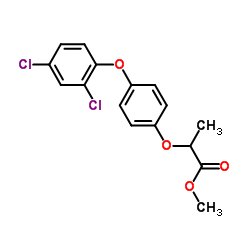Tank-mix adjuvants and pesticide residues: some regulatory and quantitative aspects.
Peter J Holloway, Nigel M Western
文献索引:Pest Manag. Sci. 59(11) , 1237-44, (2003)
全文:HTML全文
摘要
Although it is well known that judicious use of adjuvants can increase the performance of foliage-applied sprays of many agrochemicals, little information is available in the public domain about their ultimate effects on pesticide residues in treated crops. In the present work, the influence of Agral (polyoxyethylene nonylphenols), Toil (methyl esters of rapeseed fatty acids) and Bond (styrene-butadiene copolymers) on surface and crop residues of diclofop-methyl/diclofop and propiconazole in wheat and field beans was investigated using a model system simulating field practice. Pesticides were applied as commercial formulations, diclofop-methyl 378 g litre(-1) EC (Hoegrass) and propiconazole 250 g litre(-1) EC (Tilt), at their maximum approved rates, 1135 g AI ha(-1) and 125 g AI ha(-1), respectively, both in the presence or absence of the maximum rate recommended for each candidate adjuvant. No detectable residues of diclofop-methyl or propiconazole were found in wheat 35 days after any of the four applications. However, residues of diclofop were present in this crop, and those from applications containing Agral (0.07 mg kg(-1) fresh weight (FW)) or Bond (0.08 mg kg(-1) FW) were significantly lower than those with no adjuvant (0.14 mg kg(-1) FW) or Toil (0.16 mg kg(-1) FW). Unlike wheat, residues of both diclofop and propiconazole were detected in field beans after harvest. Significantly higher residues of the former were recorded from the applications with Agral or Bond (ca 0.32 mg kg(-1) FW) than with those with no adjuvant or Toil (ca 0.15mg kg(-1) FW). All the propiconazole applications containing adjuvants showed a similar significant increase in residues (0.10-0.16 mg AI kg(-1) FW) over the no-adjuvant treatment (0.05 mg kg(-1) FW) in this crop. There appeared to be little agreement between the apparent amounts of uptake, as indicated by the rates of decline of surface residues up to 5 days after application, and final residues in either target species. On wheat, surface residues of diclofop-methyl decreased from initially ca 20 to as little as 0.02 mg kg(-1) FW using adjuvants; the corresponding values for propiconazole were ca 2 to ca 0.03 mg kg(-1) FW. Recoveries of diclofop-methyl from the surfaces of field beans were much higher than those from wheat, declining from ca 30 to only ca 6 mg kg(-1) FW during the course of 5 days; the corresponding residues for propiconazole were ca 2 mg to 0.15 mg kg(-1) FW. These findings are discussed in relation to uptake results obtained with radiolabelled pesticides and adjuvants in the laboratory, and to the mandatory requirements for pesticide residue data for the authorised use of adjuvants in the UK.
相关化合物
| 结构式 | 名称/CAS号 | 分子式 | 全部文献 |
|---|---|---|---|
 |
禾草灵
CAS:51338-27-3 |
C16H14Cl2O4 |
|
Characterisation of target-site resistance to ACCase-inhibit...
2003-02-01 [Pest Manag. Sci. 59(2) , 190-201, (2003)] |
|
Genetic control of a cytochrome P450 metabolism-based herbic...
2011-05-01 [Heredity (Edinb.) 106(5) , 817-24, (2011)] |
|
Recurrent selection with reduced herbicide rates results in ...
2005-04-01 [Theor. Appl. Genet. 110(6) , 1154-66, (2005)] |
|
Time-dependent degradation and toxicity of diclofop-methyl i...
2009-06-01 [Environ. Sci. Pollut. Res. Int. 16(4) , 459-65, (2009)] |
|
Environmental effects of inclusion complexation between meth...
2005-08-24 [J. Agric. Food Chem. 53(17) , 6744-9, (2005)] |